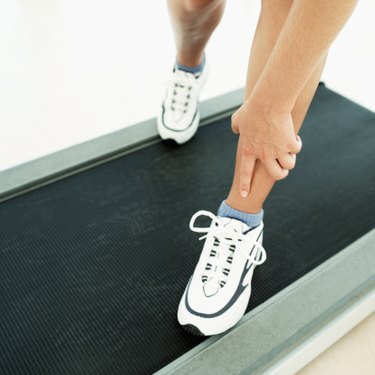
Edema occurs when a large amount of fluid accumulates in the circulatory system. Edema is common in people above age 60, but anyone can be affected by it. Some people are affected by exercise-induced edema, which usually occurs in the legs or hands, but other areas such as the feet, ankles and face can also be affected. Edema is not a disease or a disorder, although long-term edema can be a symptom of other diseases such as heart failure, kidney disease or cirrhosis.
Causes
Video of the Day
The causes of edema can include allergies, low or high blood pressure, exposure to heat or high altitudes, pregnancy, hormonal changes during menstruation and exercise. The exact cause for exercise-induced edema is not clear, but Dr. Edward Laskowski of the Mayo Clinic suggests it could be because of the way blood vessels react when you are working out. Because blood flow to the heart and lungs increases when you exercise, a reduced blood supply to the hands and legs might result in edema.
Video of the Day
Conditions
People who sweat a lot might experience edema or similar symptoms while exercising. This happens when blood vessels are pushed toward the surface of the skin. Endurance athletes can have low sodium levels, which can also cause edema because they tend to drink a lot of water after a strenuous routine. This dilutes sodium in the body and is known as hyponatremia. If followed by vomiting and confusion, immediate medical attention must be sought.
Symptoms
Visible swelling in the legs or hands during exercise is the most common symptom of exercise-induced edema. Other symptoms might include shortness of breath, change in mental state or pains or cramps in muscles. In such a case, it is best to consult a doctor immediately. Symptoms of exercise-induced edema are usually alleviated by resting after your workout.
Prevention
To prevent exercise-induced edema, you should take a five-minute break when switching between exercise routines. During this time, you should move your arms and legs in half-circle motions to increase blood flow. This will help in reducing edema to a large extent.
Considerations
It is important to consult with your doctor before beginning any exercise program. You should always start off slow and build yourself up to longer workouts. If you experience any pain or swelling during exercising, you should contact your doctor to determine the cause or treatment needed. With exercise-induced edema, the solution might be as simple as taking breaks more often during exercise.
Is this an emergency? If you are experiencing serious medical symptoms, please see the National Library of Medicine’s list of signs you need emergency medical attention or call 911.